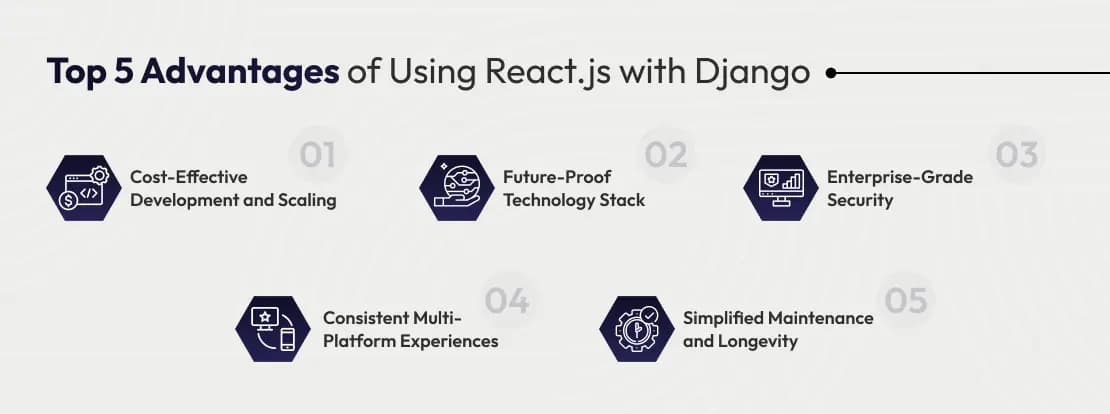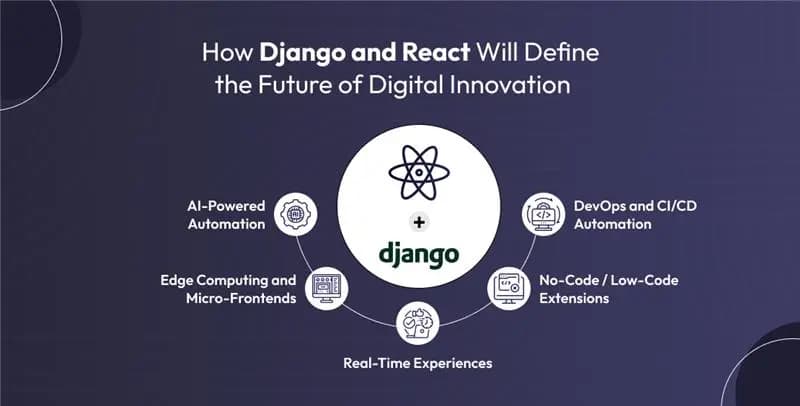
Why High-Growth Businesses Rely on Django with React for Full-Stack Development
"Key Insight: “Combining Django’s robust backend with React’s interactive frontend allows businesses to develop scalable, dynamic, and high-performance web applications that meet the expectations of today’s digital-first users.”
Are slow apps, inconsistent UIs, or scattered development teams delaying your product launches?
Even the most innovative ideas can struggle to succeed if the underlying technology is inefficient. A complex, slow, or unintuitive application can frustrate users, reduce engagement, and slow business growth. Investing heavily in features without addressing technical foundations often results in poor returns.
To overcome these challenges, businesses need a reliable backend that manages complex operations efficiently and a fast, interactive frontend that delivers exceptional user experiences. Among available technology stacks, Django with React has become a top choice for modern web application development. Industry forums, developer surveys, and case studies consistently highlight this pairing as highly effective for building scalable and interactive digital products.
Django ensures backend stability, security, and scalability, while React provides a dynamic, responsive, and component-driven frontend. Together, they streamline development, foster collaboration among teams, and prepare your applications for both current and future business needs.
Why Businesses Choose Django with React
The combination of Django and React creates a full-stack architecture that supports API-driven, modular, and highly maintainable applications. This enables teams to deliver web applications that are not only fast and scalable but also provide a rich and engaging user experience.
❖ Faster Delivery and Superior Performance
Django efficiently handles server-side operations, including database management, authentication, and business logic, while providing built-in security features that protect applications from common vulnerabilities. This makes the backend resilient, even under high traffic loads. Companies like Instagram rely on Django to manage millions of media uploads, user interactions, and backend processes efficiently.
React complements Django by updating only the necessary user interface components, avoiding full-page reloads. This leads to faster interactions, instant notifications, and dynamic search results. Platforms like Facebook, Airbnb, and Netflix utilize React to provide seamless, real-time experiences to users.
By combining Django and React, businesses can double application performance, reduce server load, and create a seamless, interactive experience that supports rapid growth and high user engagement.
❖ Deliver Modern, Interactive UI/UX
React’s component-based architecture allows developers to design interactive, modular, and visually appealing interfaces. Users enjoy single-page application (SPA) performance with smooth transitions, minimal reloads, and an app-like experience directly in the browser.
Django supports these modern interfaces with a stable, secure backend that ensures fast and reliable data delivery. The combination of Django and React allows companies to build applications that not only look great but are also robust, scalable, and secure, giving users a consistent experience across web and mobile platforms.
❖ Scalable Architecture Without Complexity
For high-growth businesses, scalability is critical. Django promotes clean, maintainable backend code and supports reusable modules. React’s component-based architecture (SPA) ensures that the frontend can scale efficiently as the application expands.
Together, Django and React enable independent scaling of the backend and frontend. This minimizes technical debt, simplifies maintenance, and aligns perfectly with a microservices architecture approach, where backend services are modular, extensible, and easy to manage.
❖ Streamlined Backend-Frontend Collaboration
The Django REST Framework (DRF) makes creating APIs straightforward, enabling React to consume backend data seamlessly. This decoupling allows frontend and backend teams to work simultaneously, improving development speed and reducing integration challenges.
Clear separation between layers also enhances code maintainability, reduces bugs, and results in a more reliable, robust, and future-proof application.
Deliver Seamless User Experiences with Secure Backends and Dynamic Frontends
| Aspect | Django + React | MERN & LAMP |
|---|---|---|
Backend Efficiency | Django ORM and built-in admin panel accelerate backend workflows | Requires additional manual setup and configuration |
Frontend Responsiveness | React SPA delivers fast, app-like user experiences | Angular/Vue can add complexity; LAMP requires full-page reloads |
Security | Built-in CSRF, XSS, SQL Injection protection | Relies on manual setup and external libraries |
Scalability | Backend and frontend scale independently | Coupled stack makes scaling more complex |
Community Support | Large, active, reliable community with packages | Fragmented support across multiple frameworks |
Developer Productivity | High due to modular, reusable components and clear separation | Moderate to high, dependent on setup |
Learning Curve | Moderate, onboarding is easier | Steeper, especially for MERN stacks |
Time to Market | Faster with built-ins, DRF, and React UI updates | Slower due to manual configuration and integration |
Top 5 Advantages of Using React.js with Django

The Django-React combination provides strategic advantages for modern application development. Here are the key benefits:
- 1. Cost-Effective Development and Scaling
One of the biggest mistakes is selecting a backend that cannot grow with your app. An app that performs well with 1,000 users may crash when it hits 100,000 users. Always plan for future growth. Consider cloud-based solutions and scalable architectures as part of your app development services strategy.
One of the biggest mistakes is selecting a backend that cannot grow with your app. An app that performs well with 1,000 users may crash when it hits 100,000 users. Always plan for future growth. Consider cloud-based solutions and scalable architectures as part of your app development services strategy.
- 2. Future-Proof Technology Stack
React and Django are supported by large developer communities and evolving ecosystems, ensuring long-term maintenance, regular updates, and access to modern tools. This stack integrates seamlessly with AI/ML solutions, cloud-native platforms, Python web development, and microservices architecture, making it adaptable for future business requirements.
- 3. Enterprise-Grade Security
Django protects against common web vulnerabilities such as SQL injection, XSS, CSRF, and clickjacking. React’s controlled rendering complements backend security to create a full-stack solution that adheres to security best practices. This is especially valuable for industries
- 4. Simplified Maintenance and Longevity
Django’s API-first approach allows businesses to use the same backend for both React web applications and React Native mobile applications. This ensures consistent data, business logic, and security across platforms while reducing redundant development efforts and simplifying maintenance.
- 5. Simplified Maintenance and Longevity
Decoupling the frontend and backend reduces dependency issues and simplifies debugging. Updates in one layer do not disrupt the other, reducing operational overhead and long-term maintenance costs. This gives technical leaders more flexibility, faster adaptation to changes, and a leaner technology budget.
Common Use Cases for Django and React
- 1. SaaS Platforms – Handle frequent updates, multi-tenant architecture, and interactive dashboards.Example: Disqus.
- 2. Real-Time Dashboards & Analytics – Low-latency data updates with React rendering only affected components.Example: NASA projects.
- 3. E-commerce Applications – Secure transactions, inventory workflows, and fast, personalized browsing.Example: Instacart.
- 4. Social Networking Apps – Real-time feeds, likes, chat windows, and activity streams.Example: Pinterest..
- 5. Healthcare Applications – Compliance, secure patient data, interactive portals.Example: Doctor On Demand.
- 6. Fintech Solutions – Secure, real-time financial data and intuitive interfaces.Example: Robinhood
Common Pitfalls to Avoid
Improper State Management
Unstructured APIs
Ignoring Security
Unoptimized Builds
How Django and React Will Define the Future of Digital Innovation

AI-Powered Automation
AI is no longer optional; it’s a must-have for personalization and efficiency. Django secures the backend while React keeps the user interface fast and interactive. This allows apps to use:
- ★Predictive Analytics: Apps can study past behavior to suggest products or automate tasks. For example, Amazon recommends items based on browsing and purchase history.
- ★Chatbots and Assistants: React enables smooth conversations while Django handles the intelligence. Sephora’s chatbot is a great example, helping customers find the right products instantly.
The result? Smarter apps that reduce manual work, support better decisions, and deliver engaging user experiences.
DevOps and CI/CD Automation
Modern apps must update quickly and with fewer errors. Django ensures backend stability, while React’s modular design allows fast frontend changes. Together, they support:
- ★Rapid Updates: Companies like PayPal and Stripe roll out new features regularly.
- ★Fewer Errors: Automated testing catches bugs early.
- ★Agility: GitHub ships new features daily by responding to user feedback fast.
This makes apps reliable, scalable, and always ready for growth.
Edge Computing and Micro-Frontends
Global apps need speed and flexibility. Django’s API-first backend and React’s components make both possible. Together, they support:
- ★Edge Computing: By processing data closer to users, apps load faster. Netflix uses this to stream content without delays.
- ★Micro-Frontends: Different teams can build separate UI modules, making apps easier to scale. Uber uses this for its rider and driver apps.
This creates fast, consistent experiences worldwide.
No-Code / Low-Code Extensions
Not every task should depend on developers. With Django and React, businesses can integrate no-code tools that let non-technical teams customize workflows and dashboards:
- ★Airtable: Lets teams design databases without coding.
- ★Shopify: Offers visual storefront editors while keeping backend logic secure.
- ★Zapier: Connects apps to automate repetitive tasks.
This speeds up digital transformation and gives teams more freedom to innovate.
Real-Time Experiences
Real-time features are now expected. With Django Channels and React, apps can deliver instant updates:
- ★Collaboration: Tools like Figma let multiple users work together live.
- ★Messaging: Slack delivers instant communication.
- ★Streaming: Twitch enables live interactions like polls and chats.
This keeps users engaged, improves retention, and creates interactive, data-driven experiences.
Why Choose Lemolite for Django with React Development?
At Lemolite Technologies, we combine Django’s backend reliability with React’s frontend flexibility to deliver scalable, secure, and future-ready applications. Our Full Stack team works across industries, including SaaS, e-commerce, healthcare, and fintech, ensuring projects meet business objectives while leveraging component-based architecture and modern Python web development best practices.
Our agile approach ensures timely delivery, seamless deployment, and ongoing support, helping businesses achieve long-term growth and maintain a competitive edge.